Related Research Articles

The Aldine Press was the printing office started by Aldus Manutius in 1494 in Venice, from which were issued the celebrated Aldine editions of the classics. The first book that was dated and printed under his name appeared in 1495.

The Doge of Venice sometimes translated as Duke, was the chief magistrate and leader of the Republic of Venice between 726 and 1797.
Admiralty law or maritime law is a body of law that governs nautical issues and private maritime disputes. Admiralty law consists of both domestic law on maritime activities, and private international law governing the relationships between private parties operating or using ocean-going ships. While each legal jurisdiction usually has its own legislation governing maritime matters, the international nature of the topic and the need for uniformity has, since 1900, led to considerable international maritime law developments, including numerous multilateral treaties.

The Rolls of Oléron are the oldest and best-known sea law regulating medieval shipping in North-western Europe. The Rolls of Oleron were the first common sea law written in the Isle of Oléron, France, in the late 12th century, prior to 1180, later evolving to encompass Northern Europe. Any later sea laws written in Northern Europe are largely based on or inspired by the Rôles d'Oléron. Sometimes known as the "Lawes of Pleron," they also formed the basis of similar agreements among 17th and 18th century pirates, known as Articles.

Sefer haYashar is a medieval Hebrew midrash, also known as the Toledot Adam and Divrei haYamim heArukh. The Hebrew title "Sefer haYashar" might be translated as the "Book of the Correct Record", but it is known in English translation mostly as The Book of Jasher following English tradition. Its author is unknown.

Book of the Marvels of the World, in English commonly called The Travels of Marco Polo, is a 13th-century travelogue written down by Rustichello da Pisa from stories told by Italian explorer Marco Polo. It describes Polo's travels through Asia between 1271 and 1295, and his experiences at the court of Kublai Khan.

NicholasJenson was a French engraver, pioneer, printer and type designer who carried out most of his work in Venice, Italy. Jenson acted as Master of the French Royal Mint at Tours and is credited with being the creator of one of the finest early Roman typefaces. Nicholas Jenson has been something of an iconic figure among students of early printing since the nineteenth century when the artist William Morris praised the beauty and perfection of his roman font. Jenson is an important figure in the early history of printing and a pivotal force in the emergence of Venice as one of the first great centers of the printing press.
Gesta Romanorum, meaning Deeds of the Romans, is a Latin collection of anecdotes and tales that was probably compiled about the end of the 13th century or the beginning of the 14th. It still possesses a two-fold literary interest, first as one of the most popular books of the time, and secondly as the source, directly or indirectly, of later literature, in Geoffrey Chaucer, John Gower, Giovanni Boccaccio, Thomas Hoccleve, William Shakespeare, and others.

Trani is a seaport of Apulia, in southern Italy, on the Adriatic Sea, 40 kilometres (25 mi) by railway west-northwest of Bari. It is one of the capital cities of the Province of Barletta-Andria-Trani.
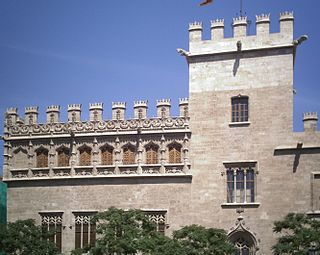
The Consulate of the Sea was a quasi-judicial body set up in the Crown of Aragon, later to spread throughout the Mediterranean basin, to administer maritime and commercial law. The term may also refer to a celebrated collection of maritime customs and ordinances in Catalan language, also known in English as The Customs of the Sea, compiled over the 14th and 15th centuries and published at Valencia in or before 1494.

The Marciana Library or Library of Saint Mark is a public library in Venice, Italy. It is one of the earliest surviving public libraries and repositories for manuscripts in Italy and holds one of the world's most significant collections of classical texts. It is named after St Mark, the patron saint of the city.
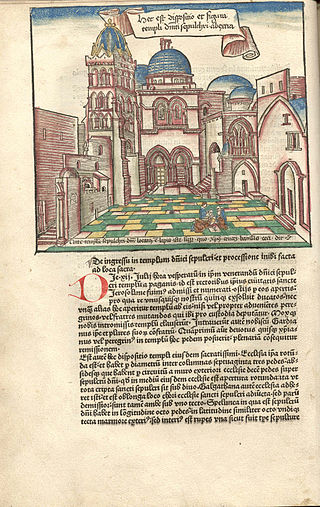
Erhard Reuwich was a Dutch artist, as a designer of woodcuts, and a printer, who came from Utrecht but then worked in Mainz. His dates and places of birth and death are unknown, but he was active in the 1480s.
The Black Book of the Admiralty is a compilation of English admiralty law created over the course of several English monarchs' reigns, including the most important decisions of the High Court of Admiralty. Its starting point is the Rolls of Oléron, which were promulgated in c. 1160 by Eleanor of Aquitaine, although the Black Book is undoubtedly later. The book itself states that the High Court of Admiralty was established during the reign of Edward I (1272–1307), although more recent scholarship places the establishment at c. 1360 during the reign of Edward III. Apart from the Rolls of Oléron, the earliest statute referred to is the Liber memorandorum (1338), of which a separate manuscript copy is available in the archives of the City of London.
Jewish printers were quick to take advantages of the printing press in publishing the Hebrew Bible. While for synagogue services written scrolls were used, the printing press was very soon called into service to provide copies of the Hebrew Bible for private use. All the editions published before the Complutensian Polyglot were edited by Jews; but afterwards, and because of the increased interest excited in the Bible by the Reformation, the work was taken up by Christian scholars and printers; and the editions published by Jews after this time were largely influenced by these Christian publications. It is not possible in the present article to enumerate all the editions, whole or partial, of the Hebrew text. This account is devoted mainly to the incunabula.
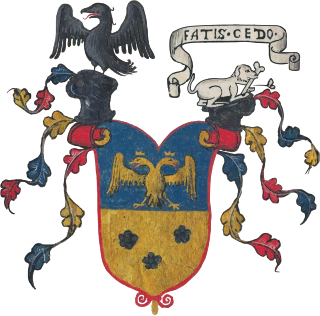
The Statutes of Scutari were the highest form of expression of the self-government of Scutari (Shkodër) during Venetian rule. There were other cities in Albania which had statutes but only those of Scutari are preserved in their fullest form. They are composed of 279 chapters written in the Venetian language of the 15th century. They were held in two copies, one in the treasury office of the city and the other on the city court office. Although similar to other Italian and Dalmatian city statutes, they have incorporated many Albanian traditional elements and institutions, such as Besa and Gjakmarrja, developing their own legal traditions through a codification of local customary laws.

Nicolò Malermi was an Italian biblical scholar credited as the first translator of the Bible from Latin into the Italian language.
Paganino Paganini, was an Italian printer and publisher from the Republic of Venice during the Renaissance. He was the original publisher of Luca Pacioli's mathematical works, Summa de arithmetica and De divina proportione, and of what is thought to be the first printed version of the Quran in Arabic.
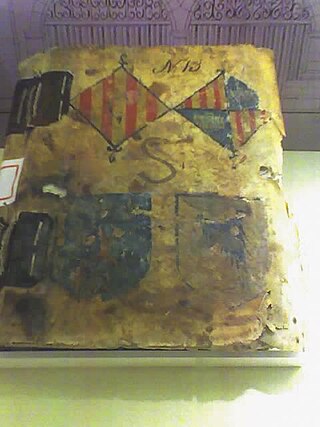
The Book of the Consulate of the Sea is a compendium of maritime law that governed trade in the Mediterranean for centuries. Of Catalan origin, it was translated into many languages and served as the basis for current international maritime law.
The Wisbuy Sea Law, also known as the Gotland Sea Law, was a compilation of medieval maritime laws created in the 1400s. These laws themselves originated from the thirteenth and fourteenth centuries. The Wisbuy Sea Law did not originate in Wisbuy but obtained its name, it has been assumed, because the exemplar of the first printed edition was kept in Wisbuy.
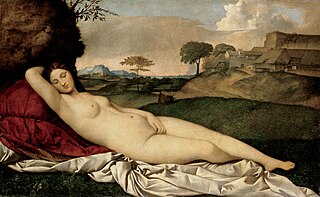
The Venetian Renaissance had a distinct character compared to the general Italian Renaissance elsewhere. The Republic of Venice was topographically distinct from the rest of the city-states of Renaissance Italy as a result of their geographic location, which isolated the city politically, economically and culturally, allowing the city the leisure to pursue the pleasures of art. The influence of Venetian art did not cease at the end of the Renaissance period. Its practices persisted through the works of art critics and artists proliferating its prominence around Europe to the 19th century.
References
- 1 2 Paul Oldfield, City and Community in Norman Italy (Oxford: 2009), 247.
- ↑ Travers Twiss, ed., Monumenta juridica: The Black Book of the Admiralty, appendix, part iv, 522 n.1
- ↑ Twiss, 523 n.1.
- ↑ Twiss, 525 n.1